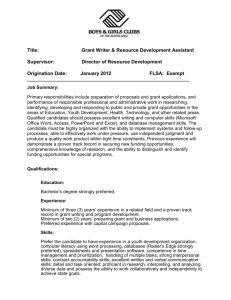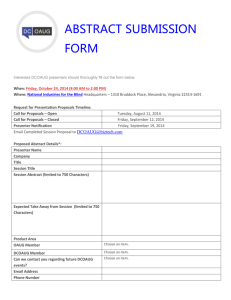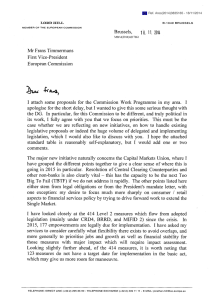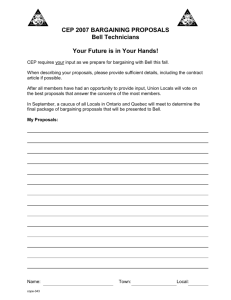Assignment Three: Making a Proposal
advertisement
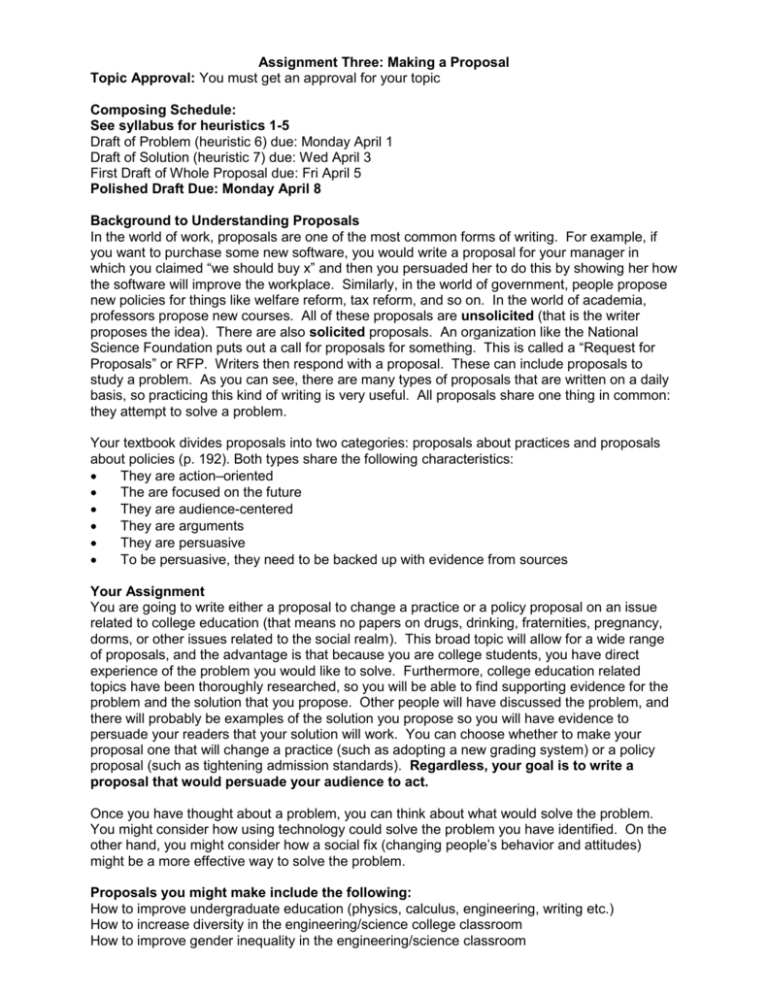
Assignment Three: Making a Proposal Topic Approval: You must get an approval for your topic Composing Schedule: See syllabus for heuristics 1-5 Draft of Problem (heuristic 6) due: Monday April 1 Draft of Solution (heuristic 7) due: Wed April 3 First Draft of Whole Proposal due: Fri April 5 Polished Draft Due: Monday April 8 Background to Understanding Proposals In the world of work, proposals are one of the most common forms of writing. For example, if you want to purchase some new software, you would write a proposal for your manager in which you claimed “we should buy x” and then you persuaded her to do this by showing her how the software will improve the workplace. Similarly, in the world of government, people propose new policies for things like welfare reform, tax reform, and so on. In the world of academia, professors propose new courses. All of these proposals are unsolicited (that is the writer proposes the idea). There are also solicited proposals. An organization like the National Science Foundation puts out a call for proposals for something. This is called a “Request for Proposals” or RFP. Writers then respond with a proposal. These can include proposals to study a problem. As you can see, there are many types of proposals that are written on a daily basis, so practicing this kind of writing is very useful. All proposals share one thing in common: they attempt to solve a problem. Your textbook divides proposals into two categories: proposals about practices and proposals about policies (p. 192). Both types share the following characteristics: They are action–oriented The are focused on the future They are audience-centered They are arguments They are persuasive To be persuasive, they need to be backed up with evidence from sources Your Assignment You are going to write either a proposal to change a practice or a policy proposal on an issue related to college education (that means no papers on drugs, drinking, fraternities, pregnancy, dorms, or other issues related to the social realm). This broad topic will allow for a wide range of proposals, and the advantage is that because you are college students, you have direct experience of the problem you would like to solve. Furthermore, college education related topics have been thoroughly researched, so you will be able to find supporting evidence for the problem and the solution that you propose. Other people will have discussed the problem, and there will probably be examples of the solution you propose so you will have evidence to persuade your readers that your solution will work. You can choose whether to make your proposal one that will change a practice (such as adopting a new grading system) or a policy proposal (such as tightening admission standards). Regardless, your goal is to write a proposal that would persuade your audience to act. Once you have thought about a problem, you can think about what would solve the problem. You might consider how using technology could solve the problem you have identified. On the other hand, you might consider how a social fix (changing people’s behavior and attitudes) might be a more effective way to solve the problem. Proposals you might make include the following: How to improve undergraduate education (physics, calculus, engineering, writing etc.) How to increase diversity in the engineering/science college classroom How to improve gender inequality in the engineering/science classroom How to improve teaching in a particular subject How to improve students’ study habits How to improve students’ exam-taking abilities How to use a particular technology effectively in a particular class How to make incoming college students prepared for first-year classes How to reduce cheating in college How to reduce grade inflation in college courses How to teach a particular concept effectively How to teach college classes more effectively (using collaborative learning) How to improve the advising system How to improve the registration system How to improve our graduation rate And so on. As your textbook points out, you must first establish that the problem exists (p. 195). Since you will be making your proposal to either university administrative officials or to professors, they themselves may not be affected by the problem. Therefore, you have to persuade your audience that this is a serious problem that needs to be solved. You will need to conduct research to find persuasive evidence you can use to prove that this is a problem that has significant effects and needs to be solved. So although interviews with peers may help you establish that the problem exists, you will need further evidence to show that this is a serious problem that indirectly affects your readers. You have to make them care about the problem and show them that it is in their interests to solve the problem. Then you will need to devise a solution and prove to your readers that your solution will solve the problem. Again, you will need evidence from sources that shows that your solution would work—it has been tried in other places or in similar situations. You will also need to prove that your solution is feasible (it can be done given budget and personnel constraints) and you may need to prove that your solution is better than other solutions that have been proposed. You will also have to consider what opponents to your solution would argue and show why they are mistaken. As you work out the rhetorical situation for this assignment, pay particular attention to the audience for your proposal. You should specify an actual audience and forum for which you would present the proposal. Consider what your purpose is---to take action or to create grass roots support for an action that someone other than the audience would take. Your audience should be asked either to undertake the action proposed or to support the action proposed. Composition The audience for this paper is the person or people to whom you plan to make your proposal. Your completed response to this assignment should clearly articulate the policy or practice you are recommending. It should review the reasons why change is necessary and demonstrate what will happen, and to whom, if your recommended policy or practice is adopted. It should also demonstrate what would happen, and to whom, if your recommendation is not adopted. It should discuss means of implementation and enforcement of the policy or procedure you are recommending, as well. To be persuasive, you will need research that supports your claims about the problem, the solution, and the implementation of the solution. At times, you will be able to find articles that deal with the problem and solution. At other times, you may have to draw on articles that deal with analogous problems and solutions. Essential Elements & Arrangement Generally, an unsolicited proposal follows a basic organization pattern of problem/solution. Here is a list of the features that usually appear in a proposal from which you can derive appropriate headings for sections: Discussion of the problem (includes a description of the problem, who it affects, and reasons why the problem must be solved). You end this section with a clear and strong proposal claim: to solve this problem, we must do y. Make sure that your proposal claim and solution matches the problem (see page 196). Discussion of the solution including: a) a full description of the solution; b) an explanation showing how your particular solution solves the problem; c) good persuasive reasons and evidence to show why the solution will be effective d) evidence to show that the solution is feasible, that is the solution can be carried out given the resources available (funds, personnel, equipment) Discussion of opponent’s objections to the solution and refutation Discussion of alternative solutions and why those will not work or will be less effective Persuasive conclusion that restates benefits and calls readers to action Your presentation of all these materials should be as persuasive to your audience as you can make it. Heuristics for the Proposal If you work through these heuristics carefully, you will have all the material you need to write an excellent proposal 1. (a) Look back at the list of problems on the assignment sheet and the lists we generated in class. Choose one problem that you are really interested in pursuing. Now write an organized paragraph in which you describe the problem and you explain who it affects. Then explain why this is a serious problem that merits attention. (b) Conduct research using the ASU databases. Find at least 6 articles through EBSCO or LexisNexis that will help you define the problem and generate solutions to the problem. You may also want to find additional sources from more scholarly databases such as ERIC (depending on your topic). 2. Now that you have described the problem and who it affects, you should be able to answer the following questions: Who is the audience for my proposal—that is who has the power to bring about change; What values do they hold that I can identify? Do we share the same values? On what values might we differ? Why will this audience care about the problem? 3. First discuss whether the problem can be solved by a policy change or by a practical proposal? Describe two different solutions to the problem. Then write out two proposal claims based on these solutions: x can be solved by y. Now list at least three reasons that would persuade me that the solution is the best solution to the problem. To ensure that your reasons match your proposal claim and are logical, write out the underlying warrant for each reason (see page 194). 4. Look back at the two solutions. Choose one solution and explain why that solution is the best solution by thinking about feasibility (see page 197). 5. Now you must consider why this problem has not been solved before now and how your audience will react to your solution. Write out the objections to your solution they will raise? Will they consider that your solution is unnecessary, too expensive, too difficult to implement, and so it is not feasible? 6. Now you are going to write a full description of the problem that includes relevant background, shows who the problem directly affects and why that is serious, and shows how the audience is indirectly affected by the problem. End this problem section with your clear strong proposal claim: to solve x, we must do y. When you have written this description of the problem, write 3 different introductions that would grab your readers’ attention and work with your description of the problem. 7. a) b) c) d) Write a complete description of your solution including: a full description of the solution an explanation showing how your particular solution solves the problem; reasons and evidence to show why the solution will work or be effective evidence to show that the solution is feasible, that is the solution can be carried out given the resources available (funds, personnel, equipment) When you have completed these heuristics, you will have all of the material you need to produce a complete first draft of your proposal. At that point, you can consider whether you want to incorporate headings in your proposal, and in what order you need to put each element. Remember that headings do not replace topic sentences.


